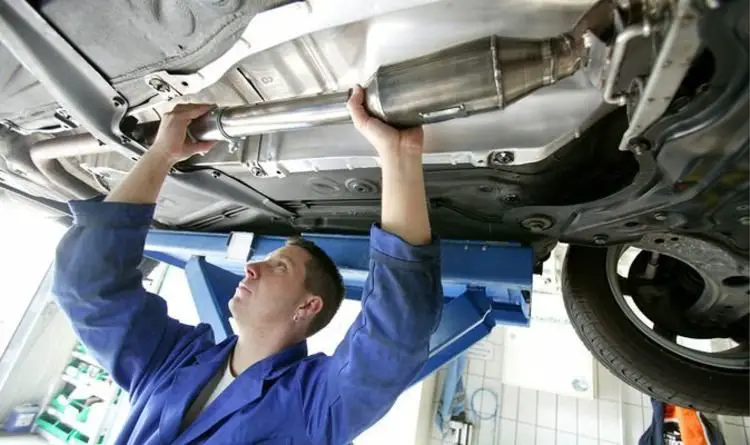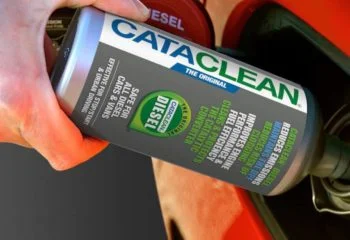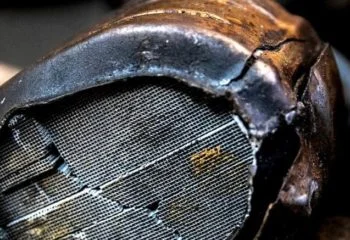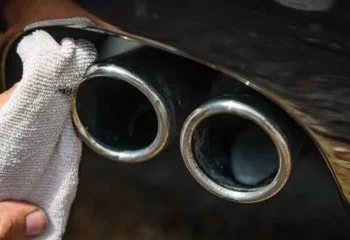Diesel particulate filters, or DPFs, have become a standard part of diesel engine exhaust systems in the United States and many other countries around the world.
DPF delete, though, is a way to bypass or remove the filter altogether. There are a number of reasons why someone might want to do this, but there are also some very good reasons why you shouldn’t.
It’s important to understand what they are before making a decision. Here we’ll take a look at what DPF delete is, what it does, and some of the pros and cons involved.
What's in this post?
What is DPF and What does it do?
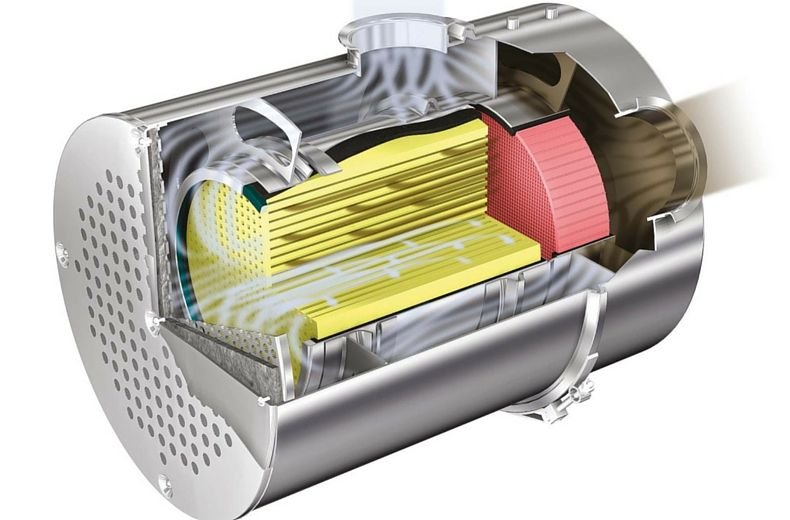
A DPF, or Diesel Particulate Filter, is a device that is installed in the exhaust system of a diesel engine.
The DPF is usually located near the back of the car, close to the tailpipe. In some cases, it may be located under the floor of the car or in the engine bay.
If you are unsure where your car’s DPF is located, consult your owner’s manual or take it to a qualified mechanic for inspection.
The DPF traps particulate matter, or soot, from the exhaust gas and prevents it from being emitted into the atmosphere.
Soot is a major contributor to air pollution, so the DPF helps to reduce emissions and improve air quality. In addition, the DPF also helps to extend the life of the engine by preventing soot from build-up on engine components.
The DPF works by using a porous ceramic or metal honeycomb to trap particulate matter.
The honeycomb is coated with a catalyst, typically platinum or palladium, which causes a chemical reaction that breaks down the soot into carbon dioxide and water vapor. These gases are then emitted through the exhaust system.
Over time, the pores of the honeycomb can become clogged with soot and will need to be cleaned. This can be done either manually or through a regeneration process, where the soot is burned off using heat from the engine.
DPFs are required on all new diesel engines in order to meet emission standards. However, they can also be retrofitted to older engines. If you are considering retrofitting a DPF to an older engine, it is important to consult with a qualified mechanic to ensure that the engine is compatible and that the installation is done properly.
What is DPF delete and what does it do?
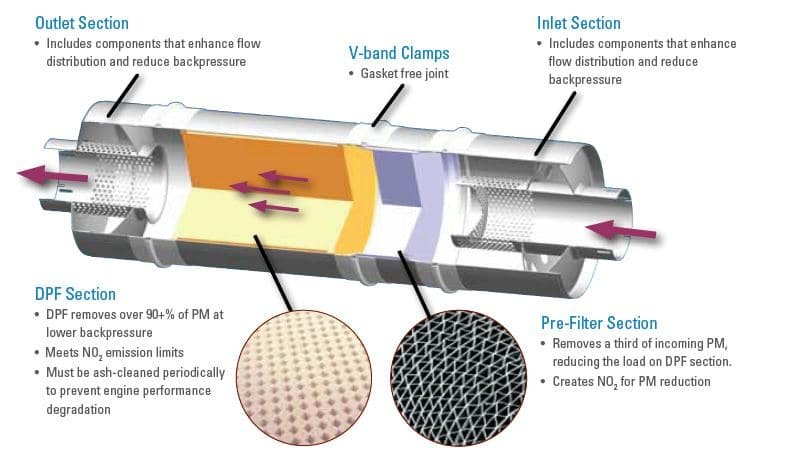
DPF delete is a process that involves removing the diesel particulate filter from a vehicle. The DPF is a device that is designed to trap soot and other particles that are emitted from the engine.
However, over time the DPF can become clogged, which can reduce the performance of the engine and cause the vehicle to emit more pollutants. By removing the DPF, the engine will be able to run more efficiently and will produce fewer emissions.
Additionally, DPF delete can also improve fuel economy and increase the lifespan of the engine. While DPF delete does have some advantages, it is important to note that it is also illegal in many countries and can void the warranty on a vehicle.
As such, it is important to weigh the pros and cons of DPF delete before making a decision.
Pros of DPF delete?

There are both pros and cons to DPF delete. Some of the advantages include:
Improve performance
One of the biggest advantages to DPF delete is that it can increase horse power.
By removing the DPF, you can expect to see a 5 to 10% increase in power. This can be attributed to the fact that the DPF clogs up over time and restricts airflow.
When it’s removed, there’s less restriction on airflow, which results in more power.
Increase fuel economy
Another advantage of DPF delete is that it can lead to increased fuel economy. It has been estimated that you can get a 30 to 50% increase in your mileage by deleting your DPF.
This is because the engine doesn’t have to work as hard to push exhaust gases through the DPF. As a result, less fuel is used and you’ll see an improvement in mileage.
Longer engine life
Another advantage of DPF delete is that it can extend the lifespan of the engine.
The DPF can become clogged over time, which can put strain on the engine and cause it to wear out prematurely.
By removing the DPF, you will help to prolong the life of your engine.
Save maintenance and replacement cost
Over time, the DPF will need to be cleaned or replaced. Cleaning a DPF can cost between $500 and $1000, while replacing it can cost upwards of $4000.
By deleting the DPF, you will no longer have to worry about these costs. In addition, you may also see a reduction in other maintenance costs, such as oil changes.
Get rid of regeneration cycle
The regeneration cycle is a process that is used to clean the DPF. However, this process can take up to an hour to complete and can use a lot of fuel. By deleting the DPF, you will no longer have to go through this cycle.
Regeneration is a process in which the DPF is cleaned of soot and other particles. However, it can be expensive and time-consuming, and it can also reduce fuel economy.
A DPF delete kit replaces the DPF with a straight pipe, which eliminates the need for regeneration. As a result, many drivers believe that a DPF delete can provide significant benefits.
Cons of DPF delete
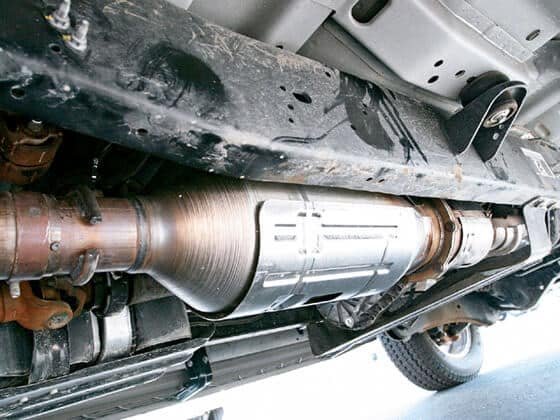
However, there are also some disadvantages to DPF delete, including:
Illegal in many countries
One of the biggest disadvantages to DPF delete is that it is illegal in many countries.
By deleting a diesel truck’s engine control unit (ECU), you are illegally tampering with emissions equipment in violation of federal regulations set forth by the EPA.
This includes removing any type of emissions-related aftermarket parts or components from the vehicle that are intended to reduce pollutants from being released into the atmosphere.
Additionally, many state and local municipalities have their own laws banning any attempts to remove or tamper with emission systems for diesel trucks, including performing a DPF delete.
This means that you could be subject to fines and other forms of punishment for carrying out such an action as well as voiding your truck’s warranty if applicable.
This includes the United States, Canada, and Australia. In these countries, it is against the law to remove the DPF from a vehicle.
As such, if you’re caught with DPF deleted, you could be subject to a fine or other penalties.
Increased emissions
While deleting the DPF can lead to increased power and fuel economy, it can also result in increased emissions. This is because the DPF helps to trap harmful particles that would otherwise be released into the atmosphere.
Without the DPF, these particles will be released, which can be damaging to the environment.
Environmentally-unfriendly
As mentioned, deleting the DPF can result in increased emissions. This is because the DPF helps to trap harmful particles that would otherwise be released into the atmosphere.
Without the DPF, these particles will be released, which can be damaging to the environment.
Should you do a DPF delete on your vehicle?
Whether or not you should do a DPF delete on your vehicle is a decision that you will need to make based on the pros and cons.
If you live in a country where DPF delete is legal, and you’re looking for ways to improve performance and fuel economy, then deleting your DPF may be a good option.
However, it’s important to weigh the pros and cons carefully before making a decision. Deleting your DPF can lead to increased emissions, which can be damaging to the environment. As such, you need to decide whether the benefits are worth the potential negative impact on the environment.
How to do a DPF delete on your car?
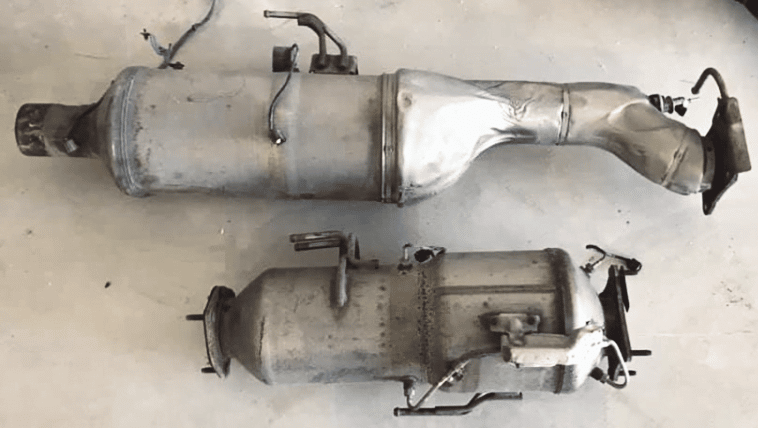
If you have decided to do a DPF delete on your car, there are a few things that you need to do.
First, you need to purchase a DPF delete kit. These kits can be purchased online from store like DPF Delete Shop or from certain aftermarket retailers.
Once you have the kit, you will need to remove the old DPF filter from your car’s exhaust system. This can be a tricky process, so it is advisable to get some help from a mechanic or someone with experience.
After the old DPF filter has been removed, you will need to install the new DPF delete pipe. This pipe will replace the old DPF filter and will allow exhaust gases to flow freely through the exhaust system.
Once the new pipe has been installed, you will need to reconnect the exhaust system and test it to make sure that it is working properly.
Finally, you will need to reset the car’s computer. This can be done by disconnecting the battery for a few minutes and then reconnecting it.
Once the computer has been reset, the DPF delete process will be complete.
How much does it cost to delete DPF?
The cost of deleting DPF can vary depending on the make and model of your car, as well as where you get the delete kit from.
However, it is generally advisable to expect to pay between $3000 and $10000 for a complete DPF removal, including labor cost.
This cost may be higher or lower depending on the specific make and model of your car.
Problems may happen after DPF removal
Even though deleting the DPF can offer some advantages, there are also some potential problems that may occur after the DPF has been removed.
DPF warning light
One of the most common problems is the DPF warning light. This light will come on if the car’s computer detects that the DPF has been removed.
If this happens, you will need to take your car to a mechanic to have the light reset. Otherwise, it will continue to stay on and may eventually cause damage to the car’s engine.
Limp mode
Another potential problem is that the car may go into limp mode. This is a safety feature that is designed to protect the engine from damage.
If the car goes into limp mode, it will reduce the power and performance of the engine to prevent further damage.
This can be a major problem if you are trying to use the car for performance driving or racing.
Flashing coil light
Another common problem is that the coil light will begin to flash. The light will start flashing if the coil gets too hot.
When the DPF is in place, it filters out soot from the exhaust gas. This soot buildup can clog the filter and cause the coil to overheat.
Without the DPF in place, there is nothing to filter the soot and it can build up on the coil, causing it to overheat.
The light will start flashing when the coil gets too hot in order to prevent damage to the engine.
Traction light
One of the most common Problems with a DPF Delete is the check engine light or traction control light comes on. This is caused by the fact that when the DPF is removed, it can cause the vehicle to produce more soot than usual.
The extra soot ends up getting into the engine and can cause problems with how the engine runs. The check engine light or traction control light will come on as a result of this.
If you have a DPF Delete and notice either of these lights come on, it’s important to take your vehicle to a mechanic to have it checked out.
Engine failure
In some extreme cases, engine failure can occur after the DPF has been removed. This is usually caused by a combination of factors, such as the car being driven too hard or the DPF delete kit not being installed properly.
If you do delete the DPF, it’s important to make sure that the car is not driven too hard and that the delete kit is installed correctly.
MOT failure
Another potential problem is that the car may fail its MOT. This is because the DPF is designed to help reduce emissions and without it, the car will produce more emissions than usual.
If the car fails its MOT, it will need to be repaired before it can be driven on the road again.
It is important to note that not all states or countries have an MOT test.
Useful read: What Is a Cat Back Exhaust System: Pros, Cons and Cost
DPF delete vs DPF remove
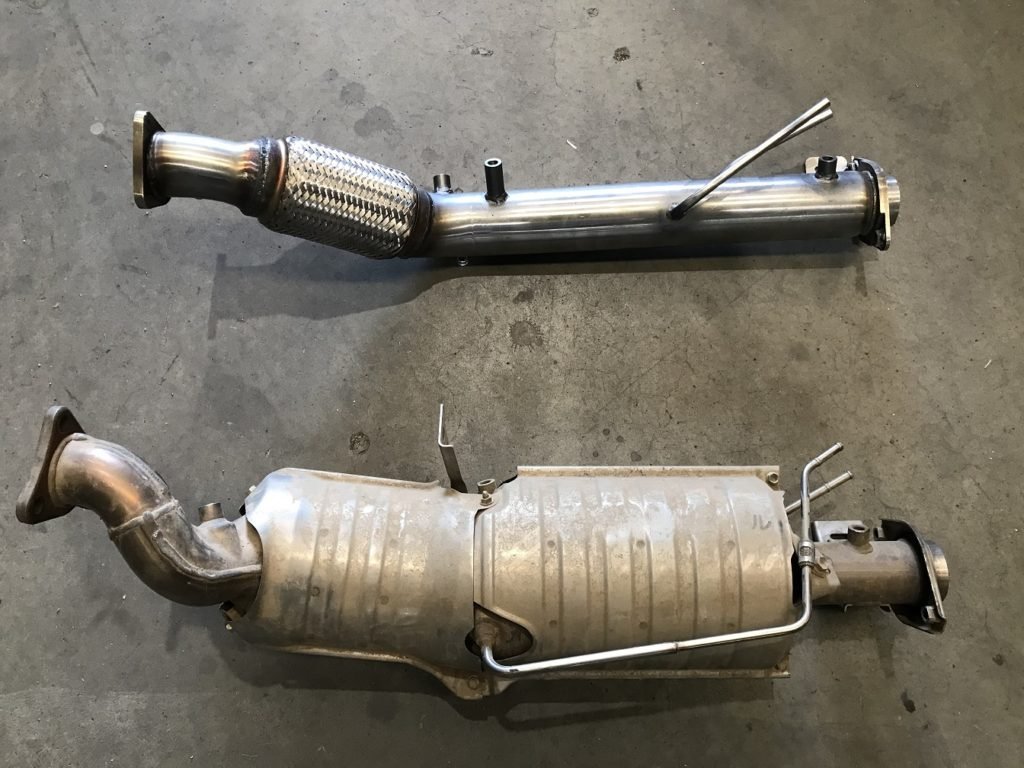
When you delete the DPF, it’s important to understand the difference between a DPF delete and a DPF remove.
DPF delete is a software solution that removes the DPF filter from the ECU’s programming. This means the ECU no longer recognizes the DPF filter, and the engine will run as if the filter does not exist.
A DPF remove, on the other hand, physically removes the DPF filter from the exhaust system. This can be done by a mechanic, and it’s a more permanent solution than a DPF delete. Because the filter is physically removed, there is less chance of it causing problems in the future.
Do you need to tune after DPF delete?
Yes, you will need to tune the car after a DPF delete. This is because removing the DPF filter can change the way the engine runs.
Tuning the car will help ensure that the engine is running correctly and that there are no problems.
You will need a dpf delete tuner or a programmer to make the changes to your car’s computer.
FAQs about DPF Delete
How much HP does a DPF Delete add?
A DPF Delete can add up to 100 hp to your vehicle. This is because the DPF Delete removes the restriction on the exhaust, allowing the engine to breathe more freely and produce more power.
In addition, the DPF Delete also provides a weight savings of up to 50 pounds, which can further improve performance.
If you are looking for a way to boost your vehicle’s horsepower and performance, a DPF Delete is an excellent option to consider.
Do you need to remap after DPF removal?
After the DPF has been removed from the system, it is important to have the ECU remapped in order for the engine to run properly.
The DPF is responsible for trapping soot and particulate matter from the exhaust gas, and without it, these toxins can build up and cause damage to the engine.
The ECU controls the engine’s fuel injection and timing, and without the DPF, it will need to be adjusted in order to compensate for the loss of this filtration system.
In most cases, a professional shop that specializes in ECU remapping can handle this process quickly and easily.
However, it is always important to consult with your mechanic or tuning specialist before making any changes to your vehicle’s ECU.
Does DPF removal cause smoke?
Yes, but it is important to understand the reasons behind this before making a decision about which route to take with your vehicle.
The DPF, or diesel particulate filter, is responsible for trapping soot and other particles emitted by the engine.
When these particles build up, they can cause the DPF to become blocked. As a result, removing the DPF will cause an increase in smoke emissions.
EGR delete vs DPF delete
When it comes to egr delete vs dpf delete, there are pros and cons to both options. An egr delete can help improve engine performance and fuel economy, but it can also increase emissions. A dpf delete, on the other hand, can improve engine performance and reduce emissions, but it can also decrease fuel economy. S
o which is the better option? Ultimately, it depends on your specific needs and objectives. If you’re looking to improve engine performance and fuel economy, an egr delete may be the better option. If you’re looking to reduce emissions, a dpf delete may be the better choice.
Does a DPF stop black smoke?
Yes. DPF is a device that is fitted to the exhaust system of a diesel engine in order to trap and filter out soot particles from the exhaust gases. Soot is a major component of black smoke, which is emitted from the exhausts of diesel engines.
The trapping and filtering action of the DPF reduces the emission of black smoke, and therefore also helps to improve air quality.
As well as stopping black smoke, DPF’s also help to reduce other harmful emissions from diesel engines, such as nitrogen oxides (NOx) and particulate matter (PM).
Therefore, fitting a DPF can have a positive impact on both air quality and engine performance.
Can a blocked DPF damage turbo?
Yes, a blocked DPF can damage the turbocharger. The DPF is responsible for trapping soot and particulate matter from the exhaust gas, and when it becomes full, it can cause backpressure to build up in the exhaust system.
This backpressure puts strain on the turbocharger, and can eventually lead to failure. In addition, a blocked DPF can also cause engine overheating, as the trapped soot prevents heat from escaping through the exhaust system.
How often does a DPF regenerate?
The DPF regeneration process typically occurs every 200-300 miles, depending on driving conditions.
During regeneration, the engine’s exhaust gas temperature is increased in order to burn off the trapped soot and particulate matter.
This process usually takes around 20 minutes to complete, and can be performed manually or automatically.
I have a DPF delete pipe, do I still need to regenerate?
Yes, you will still need to carry out the DPF regeneration process, even with a DPF delete pipe fitted.
The DPF delete pipe simply removes the physical filter from the system, but it does not change the fact that soot and particulate matter will still be produced by the engine.
As a result, the regeneration process is still necessary in order to prevent these toxins from building up and causing damage to the engine.
How often should I service my DPF?
It is recommended that you service your DPF every 20,000 miles, or every two years, whichever comes first.
During a service, the filter will be cleaned and checked for any blockages.
If the filter is found to be blocked, it will need to be replaced.
Can I clean my DPF myself?
Yes, you can clean your DPF yourself, but it is important to make sure that you do so safely and effectively.
Cleaning the filter involves removing it from the exhaust system and using compressed air and a brush to remove any soot or particulate matter.
Once the filter is clean, it can be re-fitted to the exhaust system.
However, if you are not confident in your ability to clean the filter correctly, it is best to leave it to a professional.
What year did DPF start?
In 2007, the car industry saw the introduction of the diesel particulate filter (DPF). The DPF was designed to reduce particulates and NOx in the exhaust stream, which in turn would reduce environmental pollution.
What are the symptoms of DPF blockage?
Common symptoms of DPF blockage include loss of power, increased fuel consumption, and difficulty starting the engine. In some cases, the DPF warning light may also come on.
If the DPF becomes too blocked, it can cause serious engine damage.
How do I know if my DPF needs replacing?
One of the most common symptoms is a decrease in fuel economy. This is because the DPF traps soot and other particles from the exhaust, and as it becomes full, it puts additional strain on the engine.
Another symptom to look for is an increase in emissions from the tailpipe. If you notice black smoke or an unusual smell coming from the car, this could be an indication that the DPF is full and needs to be replaced.
Can I drill holes in my DPF filter?
No, drilling holes in the DPF filter is not recommended. This will cause the filter to become less effective at trapping soot and particulate matter, and could eventually lead to engine damage.
What is the difference between a DPF and a catalytic converter?
The main difference between a DPF and a catalytic converter is that a DPF filters out particulates, while a catalytic converter reduces emissions.
A DPF is typically fitted to diesel engines, while a catalytic converter is usually fitted to petrol engines.
Do all cars have DPFs?
No, not all cars have DPFs. However, an increasing number of vehicles are being fitted with them in order to meet stricter emissions standards.
At present, most new diesel cars will have a DPF fitted as standard.
How long does a DPF last?
The lifespan of a DPF will depend on a number of factors, including how the vehicle is used and how well the DPF is maintained.
As a general rule of thumb, most DPFs will last for around 100,000 miles. However, this can vary depending on driving habits and conditions.
What is the penalty for removing a DPF?
The penalty for removing a DPF from a vehicle can vary depending on the state or country in which you are caught.
In some states, such as California, it is against the law to remove a DPF from a vehicle. This can result in a fine of up to $1,000.
In other states, such as Texas, there is no specific law against removing a DPF. However, if you are caught driving a car with a deleted diesel engine, you may still be subject to EPA fines.
The amount of the fine will depend on the severity of the issue, but it could be as much as $37,500 per day for a major infraction.
Can you put a DPF back after delete?
Yes, it is possible to put a DPF back after a delete. However, it’s important to understand that this may not be the best solution.
Putting a DPF back after a delete can cause problems because the ECU will still think that the DPF filter is in place. This can cause the check engine light or traction control light to come on.
Conclusion
DPF delete, or diesel particulate filter delete, is a process that removes the diesel particulate filter from a diesel engine. This can be done for performance reasons, to improve fuel economy, or to remove a restriction on the engine.
There are pros and cons to doing this procedure, and it is important to weigh all of the factors before making a decision.
However, you should remember that DPF delete is illegal in many countries, we advise you to check the local regulations before considering this mod.
If you decide that DPF delete is right for you, make sure you work with a qualified mechanic who knows what they’re doing.

